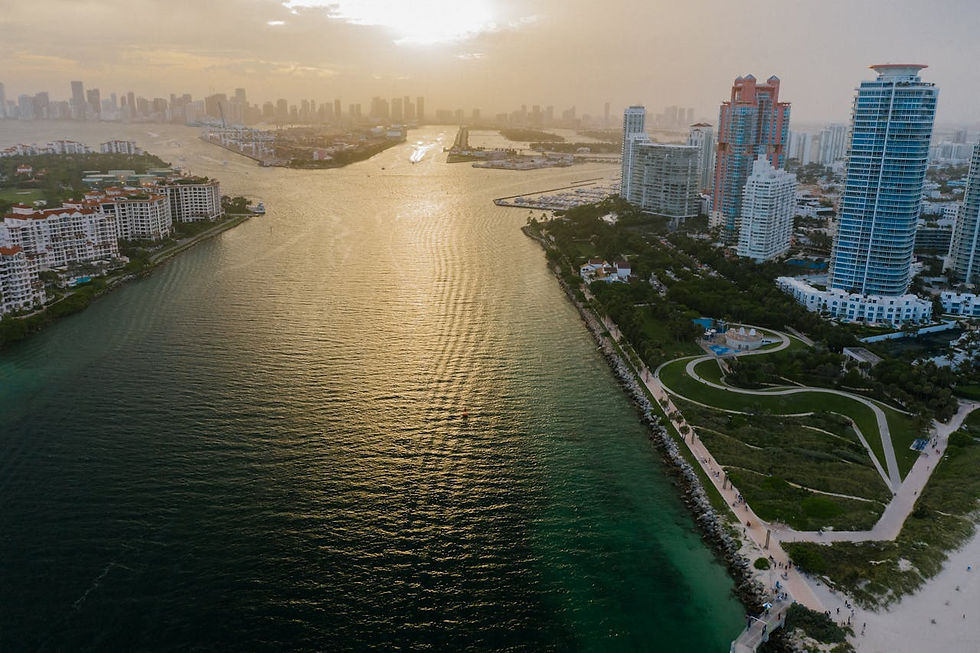Is Miami Sinking? The Growing Threat of Rising Sea Levels and Flooding.
- Rafe M.

- Jan 16
- 4 min read
Miami, one of the most iconic coastal cities in the United States, is facing an alarming reality. Experts have long warned about the effects of climate change on vulnerable coastal cities, but Miami is now facing a growing risk of becoming submerged. From rising sea levels to sinking buildings, the city’s future is at stake, and its residents are beginning to feel the pressure.
In this article, we’ll explore the science behind these concerns, the evidence pointing to Miami’s sinking, and what residents, investors, and tourists need to understand about this rapidly changing situation.

The Growing Threat of Rising Sea Levels.
Miami sits on a delicate piece of land known as a limestone bedrock, which is highly porous. This makes it susceptible to rising sea levels. The threat has been growing for years, and recent studies are showing the alarming reality of just how much water is slowly encroaching on the city.
According to climate experts, sea levels around Miami have risen by several inches over the past few decades, and projections suggest that this rate will only accelerate in the coming years. As sea levels rise, saltwater is infiltrating freshwater aquifers, and flooding is becoming an increasingly common problem. The risk of Miami being submerged in the near future is no longer a distant theory—it’s happening right now.
Buildings Are Sinking: What’s Happening to Miami’s Infrastructure?
One of the most startling revelations about Miami’s vulnerability is the sinking of its buildings. Coastal cities are known for dealing with issues like land erosion, but in Miami, the combination of rising sea levels, ground subsidence, and poor infrastructure is causing buildings to sink at an alarming rate.
Recent studies have highlighted that some of the city's coastal buildings are sinking, particularly those built decades ago without considering modern-day challenges like climate change and rising water levels. These buildings are no longer just standing still—they’re slowly sinking into the ground. This issue is exacerbated by the fact that many properties in the region are built on shifting, unstable land.
As a result, homeowners and investors are starting to ask: "Are these buildings safe? Should I be worried about sinking or flooding?" And with good reason. Areas like Miami Beach, which already deal with "sunny day flooding" (flooding on clear days due to rising tides), are seeing increasing damage to infrastructure, including roads and buildings.

The Faena House: A Symbol of Miami’s Vulnerability.
One of the most high-profile properties affected by this sinking trend is Faena House, a luxury residential building located along the coast. Though not immediately sinking in the way some others are, the property is in a high-risk area. The building is often brought up in discussions about Miami's vulnerability to flooding and sinking.
While Miami's beachfront properties have historically been attractive for their stunning views, the increasing frequency of flooding and the sinking of the land around them is causing many to rethink their investments. Some residents are already starting to ask if it’s time to move away from these high-risk properties, and if other places in the city are also at risk of sinking due to climate change.
Is Miami Really Underwater or Just Floating Away?
Miami’s future may not involve sinking into the sea in the traditional sense, but rising water levels and a sinking landmass are creating a scenario where parts of the city could be underwater in the next few decades. The term "floating away" has been used to describe the growing risk of Miami's coastal land becoming submerged under water as sea levels continue to rise.
In fact, projections suggest that large swaths of Miami could be underwater by the end of the century, potentially displacing thousands of residents and causing catastrophic damage to property. While Miami's infrastructure is doing its best to adapt (with sea walls, pumping systems, and raised streets), it remains unclear if these measures will be enough to combat the rising tides for long.

Is Miami Getting Flushed Away? The Flooding Crisis.
Miami’s floodwaters aren’t just a theoretical problem—they're already happening. Known for its regular "sunny day flooding," parts of the city are routinely flooded during high tides, even when there’s no storm. This has become an increasing concern for those who live and work in the city, and is a direct result of rising sea levels.
Flooding has also been linked to the sinking of infrastructure, as roads and buildings gradually sink due to the land’s instability. With more extreme weather events predicted in the coming years, Miami’s flooding problem could quickly escalate, leaving the city with even more severe issues to contend with.
What Can We Do to Save Miami?
The good news is that Miami isn’t without options. Authorities are currently working on a number of climate adaptation strategies to help mitigate the damage caused by rising sea levels and land subsidence. Some of the solutions include:
Rebuilding with better materials: New buildings are being constructed with better materials and techniques to withstand the challenges posed by rising sea levels.
Flood prevention measures: Miami is investing in flood prevention infrastructure, such as pumping systems, raised roads, and seawalls.
Preserving natural barriers: Efforts are being made to preserve mangroves and coral reefs, which can serve as natural buffers against flooding and storm surge.
However, even with these measures in place, there’s still an undeniable risk that Miami may not be able to escape the effects of climate change entirely. It’s up to residents, local governments, and global leaders to act quickly in order to preserve the city for future generations.
Should You Be Concerned?
As an investor or a potential homebuyer in Miami, the question on everyone’s mind is: "Should I be concerned about the future?" The answer is complex. While Miami continues to be a vibrant city, offering great real estate opportunities, the effects of climate change are undeniable.
If you’re considering buying property in Miami, it’s crucial to understand the risks involved. Be aware of the potential for flooding and infrastructure issues, and consider investing in newer, better-built properties that are designed with climate change in mind. Additionally, make sure to stay informed about the city’s ongoing efforts to adapt to the changing environment.
For now, Miami remains a beautiful, bustling city, but the question remains: How much longer will it stay above water?
Comments